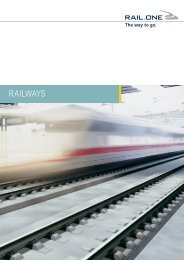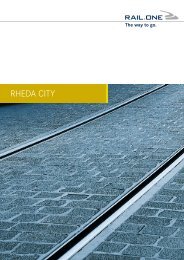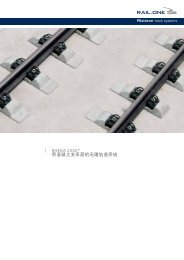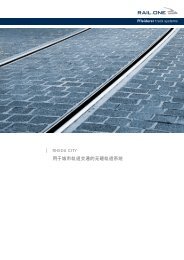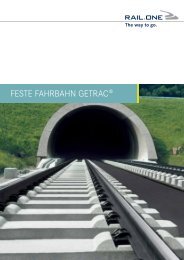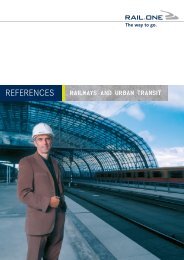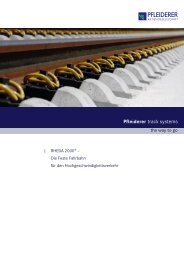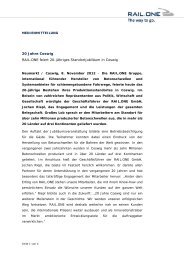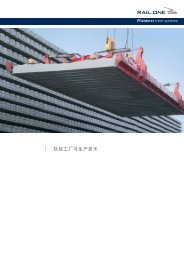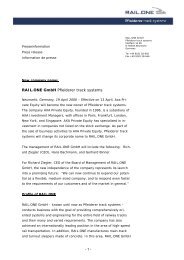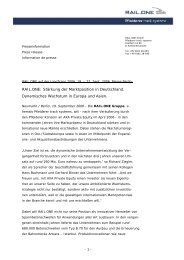rheda 2000® ballastless track system - RAIL.ONE GmbH
rheda 2000® ballastless track system - RAIL.ONE GmbH
rheda 2000® ballastless track system - RAIL.ONE GmbH
- No tags were found...
You also want an ePaper? Increase the reach of your titles
YUMPU automatically turns print PDFs into web optimized ePapers that Google loves.
RHEDA <strong>2000®</strong>1617Installation techniquesMaximum precision during installation ensures exactand long-lasting <strong>track</strong> positioningThe great majority of the bi-block sleepers of the RHEDA <strong>2000®</strong> <strong>system</strong>are produced locally in especially constructed production plants.This arrangement reduces transport costs to a minimum. As a result of thesimple installation technology, which does not require special equipment,local <strong>track</strong> and civil-engineering companies can install the RHEDA <strong>2000®</strong>. Inaddition, a surveying technique especially developed for the RHEDA <strong>2000®</strong><strong>system</strong> assures great exactness of <strong>track</strong> position and geometry. The alignmenttechniques used here – using spreader bars and spindle-base adjustmentunits – enable precise alignment and securing of the <strong>track</strong> panel, evenunder the most unfavourable of construction-site installation conditions.The spreader-bar adjustment <strong>system</strong> involves a combined technique consistingof the following two elements: vertical adjustment by means ofspindles attached at the ends of the sleepers, and horizontal adjustmentby special spreader bars at the centre of the sleepers. The spindle adjustmentsupports the <strong>track</strong> panel directly at the rail base and enables bothvertical as well as horizontal <strong>track</strong>-panel alignment.With both techniques, the adjustment procedures are completed with approvalgranted by the survey engineer. The next step includes the castingof the sleepers into a <strong>track</strong> concrete layer. Here, two measured points onthe rail may at intervals of 5 m have position or height differences of noGeneral overview of RHEDA <strong>2000®</strong> production sequences, consisting of manual and mechanised steps of workPreparation ofthe substructureAssembly of the<strong>track</strong> panelRough alignmentof the <strong>track</strong> panelInstallation ofthe <strong>track</strong> formworkEmbankmentPlacing of the frost protection layerusing conventional constructionmachinesPlacing of the hydraulically bondedlayer using conventional constructionmachinesAssembly on sitePlacing reinforcementPlacing of single sleepers and installationof <strong>track</strong> reinforcementInstallation of rails (temporary or final)Manual rough alignmentLifting and rough alignment of the <strong>track</strong>panel using manual devices (rail jacks,<strong>track</strong> alignment frames, etc.) and surveyinstrumentsPossible kinds of formworkIndividually / manually (on site) manufacturedformwork (e.g., timber formwork)Pre-fabricated formwork <strong>system</strong> elements(usually of steel)Pre-fabricated (steel) formwork <strong>system</strong>elements with integrated rails forconstruction vehiclesCivil structures• Preparation of the civil structuresurface and the possible <strong>track</strong> fixationelements according to the individualsub-/superstructure designPre-assemblyPre-assembly of the <strong>track</strong> panels onspecial sitesTransport and placing of the complete<strong>track</strong> panels to the final installationlocationAutomatic rough alignmentLifting and rough alignment of the <strong>track</strong>panel using automatic devices: e.g.,rough alignment machines, remotelycontrolled by electronic surveyinginstrumentsLOGISTIC ACTIVITIES



